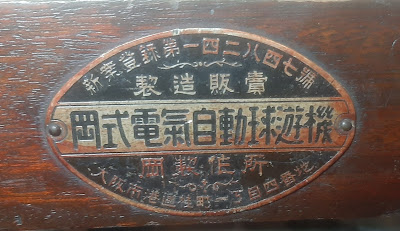Year: ~1931 (around 1930-1932)
Company: 岡 (Oka)
Oka are famous for making early pachinko machines, their oldest around 1929. They are not the first to make pachinko machines, that would be ON Shokai. There are no known existing copies of those machines, so currently the oldest known existing pachinko machine is by Oka.
 |
| Oka company plaque. Despite it saying "electric", only some of their machines used electricity. |
The first pachinko machines operated on sen coins. The earliest machines would have their wins paid by hand by the operator who would place coins in a bottom tray. This is one of the early machines designed to automatically pay you coins for a win. Pachinko machines would be changed to dispense balls around 1937, due to money gambling machines being prohibited by regulations.
Kazuo Sugiyama of the Birth Of Pachinko Museum says this machine was probably made between 1930 and 1932.
 |
| back of machine |
This machine had been modified at some point. Originally, this piece of metal was bent so that a ball would come up and be directed downward toward the left-most hole.
 |
| 4 nails were removed from the playfield. These nails would deflect the ball away from the curved metal, and prevented the ball from getting stuck. |
I have drawn the original ball path. The ball would only go here if the player shot too hard.
 |
| the original ball path if you shot too hard. This modification was probably done by an operator at a later date to make the game play a bit more like pachinko machines did in the late 1930s. |
Each of the 3 hearts has a winning hole behind it, but they are very difficult to enter. In the below photo you can see it is not a cup to enter, like in a pachinko machine from the 1940s onward. It is a thin metal channel the ball would have to roll down.
 |
| looking down behind a heart |
This is the channel:
But luckily the center block is much easier to hit. It slants inward like a funnel, leading to a hole. Even if you do not enter the center heart, the ball would still enter the center block. This seems to make the hole in the center heart unnecessary, so I wonder if sometimes people would remove the center block funnel...
All 4 winning holes feed the ball to the same junction point at the top, at the back. The ball then triggers the upper lever, and then falls down the chute to the left where it enters the playfield, ready to be shot again.
 |
| how a winning ball travels. The top orange dot is where the ball hits the payout lever. The bottom dot is where the ball returns to the playfield. |
This is all very standard for a pachinko of this era.
But look at the 2nd path. When a ball comes from the right orange circle it hits the 2nd payout lever. (marked by the purple circle)
The left-most hole on the playfield takes the ball to the "lose" hole. But all along the bottom, the ball gets funneled into a "lose" hole that also can pay out.
 |
| payout tray with bent corner, blocking one of the two coin payout chutes |
It is very easy to bend the metal to let the machine pay 2 sen again.











No comments:
Post a Comment